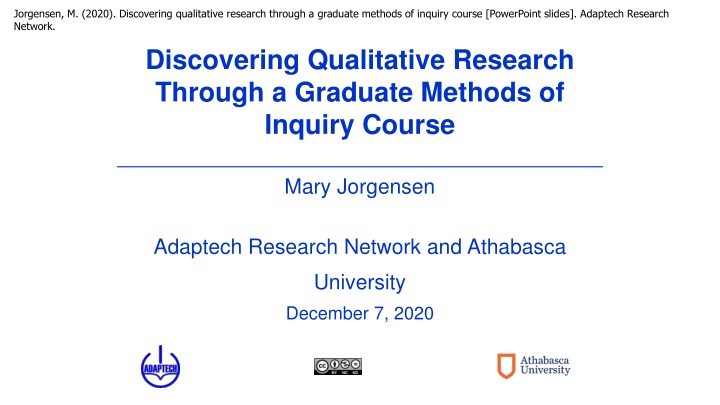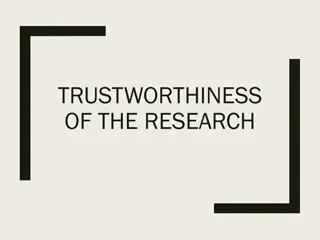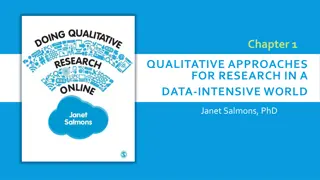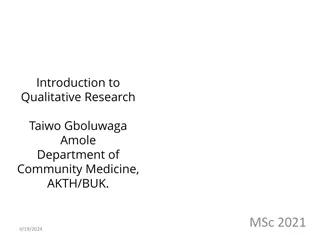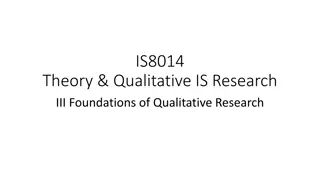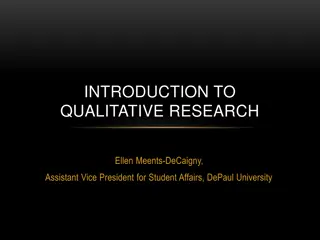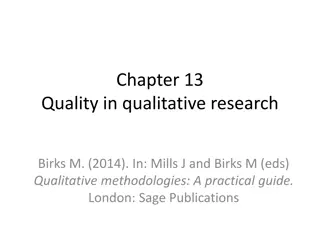Qualitative Research Methods Overview
In this presentation, different types of qualitative research methods are explored, including ethnographic research, case studies, phenomenological research, and grounded theory. Each method is discussed in terms of its unique approach and characteristics, providing a comprehensive overview for those interested in qualitative research.
Download Presentation

Please find below an Image/Link to download the presentation.
The content on the website is provided AS IS for your information and personal use only. It may not be sold, licensed, or shared on other websites without obtaining consent from the author.If you encounter any issues during the download, it is possible that the publisher has removed the file from their server.
You are allowed to download the files provided on this website for personal or commercial use, subject to the condition that they are used lawfully. All files are the property of their respective owners.
The content on the website is provided AS IS for your information and personal use only. It may not be sold, licensed, or shared on other websites without obtaining consent from the author.
E N D
Presentation Transcript
Jorgensen, M. (2020). Discovering qualitative research through a graduate methods of inquiry course [PowerPoint slides]. Adaptech Research Network. Discovering Qualitative Research Through a Graduate Methods of Inquiry Course Mary Jorgensen Adaptech Research Network and Athabasca University December 7, 2020
Types of Qualitative Research Ethnographic research Case study Phenomenological research Grounded theory Participatory action research 2
Ethnographic Research Long-term observation in the real world Researcher interacts with people in their daily lives Main features of ethnography: Collection & analysis of empirical data drawn from the real world contexts Make sense of events from participants perspective Data gathered from many sources (e.g. observations and informal conversations) 3
Ethnographic Research (contd) Photoethnogrpahy Pictures taken by researcher or participant are used as sources If participant takes pictures = follow-up interview with researcher Interesting presentation of results Performance ethnography A play based on a script informed by the data provides an engaging and informative dissemination option 4
Case Study Can be an individual, group of individuals, or event Suggested information to collect: Physical setting Historical background Other contexts (e.g. social, economic, and political) 5
Phenomenological research Focus = individuals perception / meaning of a phenomenon or experience Two approaches to data analysis: Ethnomethodology Describes how individuals recognize, describe, explain, and account for their daily lives Conversational analysis Examines the sequential organization of topics, management of turn taking, and practices related to opening, sustaining, and closing a conversation 6
Grounded Theory Data are simultaneously collected and analyzed to identify emerging themes to guide future data collection Theory emerges out of the data, not prior to data collection Goal = Develop theory based on empirical data The researcher needs to constantly interact with the data 7
Data Collection Methods Personal interviews Observation Discussion board 8
Group / Individual Interviews Important considerations for preparation: Hold an introductory meeting to discuss the purpose of the study and confidentiality concerns Learn the language / terms used by the participants Make an interview guide (general or specific) Train interviewers by: Asking them to read the guide Giving feedback on practice interviews 9
Group / Individual Interviews (contd) Important considerations during interview: Sequence questions from general to specific Use a constructive framework to ask for criticism Avoid why questions Some people may become defensive Try to use role play or simulation questions At end of interview: Explain what you plan to do with the data 10
Observation Researcher s different degrees of involvement: Complete observer Researcher fly-on the wall Observer-as-participant Researcher s primary role = observer, but engages with participants Participant-as-observer Researcher participates in activities with participants 11
Observation (contd) What researchers should observe: The physical environment Color and measurements of room and placement of furniture Human and social environment How people organize themselves in groups and patterns and frequencies of interactions Notes should include exact language used by participants Nonverbal communication What does not happen 12
Discussion Boards Each participant can contribute to a discussion forum when convenient Advantages Participants from many different locations can participate No need for transcription of data Disadvantages Participants can go off topic Discussion may be dominated by a subset of individuals Participants may not contribute after reading other posts 13
Critically Analyzing Qualitative Research Credibility (similar to internal validity) Transferability (similar to external validity) Dependability (similar to reliability) Confirmability 14
Credibility Researcher must be in field long enough to get a full and accurate picture Researcher must use member checks to verify interpretations of findings Types of member checks Technical (focuses on accuracy) Ongoing (Multiple verification meetings with participants) Reflexive (Collaborative verification meetings) 15
Credibility (contd) Progressive subjectivity Researchers must keep a journal or paper trail of their developing constructions Must be done throughout entire study to document any changes Triangulation Checking for consistency among information from different sources Recommended for factual data, not subjective measures 16
Transferability Research must provide sufficient context/detail to: Provide a thick description Including time, place, context, and culture in which data is gathered Allowing readers to decide to what degree the context of the study applies to their own research study 17
Dependability Researchers need to provide a paper trail of changes in methodology throughout the study An objective peer can conduct a dependability audit Attests to the quality and appropriateness of the inquiry process Researchers provide memos or journals detailing each step in the process The peer can determine if the degree of change was acceptable 18
Confirmability Qualitative data = can be traced back to participants Researchers must explain rationale for logic used to interpret data The conclusions need to be supported by the data Supportive evidence required throughout data interpretation process 19
Tips for Writing up Qualitative Findings Include a description of the researcher (including their demographic information) Include reflections on possible researcher bias Indicate the context in which data was gathered: Including social, cultural, and political contexts 20
Ways of Writing up Qualitative Results Present events in chronological order, as they occurred during data collection Use progressive focusing Start by describing a broader context and then focus on the details of a particular case Present events as a day-in-the-life description in the real world Focus on one or two critical events 21
Ways of Writing up Qualitative Results (cont d) Introduce the main characters and then tell a story Describe the main groups and how they interact with each other Tell the story from the perspective of several different stakeholders Present the research problem as a mystery to be solved Then solve the mystery by bringing the pieces of data into the story 22
Reference All of the material was taken from: Mertens, D. M. (2020). Research and evaluation in education and psychology: Integrating diversity with quantitative, qualitative, and mixed methods (5th ed.). Sage. 23
